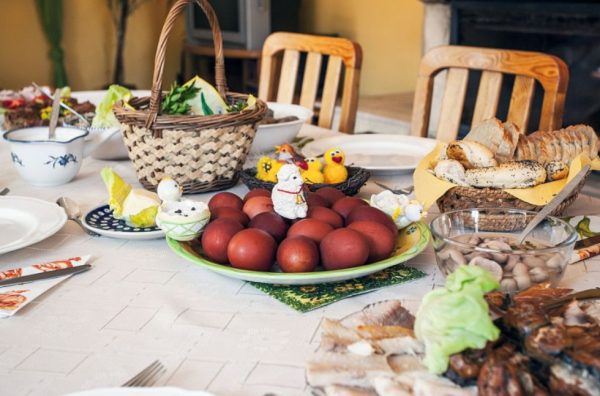
The royal emblems of King Otto of Greece (known in Greece as Othon), the crown, the scepter and the sword, were located in Tatoi during the documentation work of the cultural goods and movable objects by officials of the competent services of the Ministry of Culture. The royal emblems, about which there has been much talk and much speculation – often fanciful – were found, in very good condition, well preserved and carefully packed.
As soon as the Minister of Culture Lina Mendoni was informed about the find, she said the following: “I want to thank the relevant services of the Ministry of Culture for the extremely diligent, systematic scientific work they have been doing in Tatoi in recent years. The finding of the royal emblems of Otto, king of Greece, was unexpected. Their importance is extraordinary for the Greek state, regardless of the state change that has taken place. They are the first official insignia of the new Greek state and offer tangible traces of its continuity over time. It is obvious that the royal emblems belong to the Greek people and nation. Once their maintenance is completed, the objects, after relevant consultation with the Prime Minister and the Speaker of the Parliament, will be handed over to the Parliament of the Hellenes – Otto’s Palace – in order to be permanently displayed in the “Eleftherios Venizelos” Trophies Hall.
Gifts for the coronation of Otto
Otto, prince of Bavaria, of the house of Wittelsbach, reigned in Greece with the title of King of Greece, from 1832 to 1862. The crown and scepter were made by the famous Parisian goldsmith house Fossin et Fils, while the sword Fossin collaborated with the swordsmith Jules (?) Manceaux, of the eponymous gunsmith house.
Their construction was commissioned by Louis of Bavaria, Otto’s father, in 1835, to be given to the young king upon his coronation, which would take place, the same year, upon his coming of age. However, the ship that carried them did not arrive in Greece in time and the coronation took place without them. When Otto left Greece in 1862, he took the emblems of the throne with him, as he never accepted his eviction nor did he abdicate. Thus, the first emblems of the Greek state were since 1862 in the possession of the royal house of Bavaria.
The objects, made of gold and metal alloys, are characterized by the high artistry of their makers. They are rather simple, bearing no precious stones (except for lapis lazuli on the hilt of the sword), but the symbolism of their decorative elements is significant. They are the starting point for the tradition of shaping state symbols that would follow for the next two centuries, despite the change in dynasty and polity.
Return to Greece
The last time the three emblems were presented together was in December 1959, at the ceremony of handing them over from the House of Wittelsbach to the then King of the Greeks Paul. After diplomatic negotiations, the head of the House of Wittelsbach, Albert, offered the emblems of the throne back to Greece. The ceremony of their delivery took place in the Palace of Athens (now the Presidential Palace), in December 1959, in the presence of Prime Minister Konstantinos Karamanlis and members of the cabinet. The date was chosen to coincide with the anniversary of Otto’s arrival in Athens, in 1834, and the proclamation of the city as the capital of the new Greek kingdom. Albert’s son Maximilianos-Emmanuel presented the royal couple with the first emblems of the Greek throne, on a symbolic day for the state and its capital.
The crown was used at the funeral of King Paul, in March 1964, and at the funeral of the late Queen Frederica, in February 1981.
Although their state of preservation is very good, the Department of Conservation of Ancient and Newer Monuments of the Ministry of the Interior has already taken over, given the long time they have been in storage. The available references – among them a scientific publication – allow their safe identification. further research and study is definitely required, a task that has already been undertaken by the officers of the Directorate of Newer Cultural Heritage of the Ministry of Foreign Affairs.
Crown
Material: Gold and gilded metal, enamel, velvet. Dimensions: Height 25 cm., Max. Diameter 29 cm.
Inscription: Fossin et fils Joailliers du Roi à Paris.
The crown bears a wreath decorated with a floral band reminiscent of a laurel wreath. At this point there is an band with the signature of the artist. From there stem eight arches, decorated with ancient acanthus leaves and lion heads, from which grow respectively eight arched stems in the shape of palm branches. The whole composition is united in the center where the symbol of the crown is formed with the globe, below the cross. Inside the purple velvet is preserved, but shows extensive weathering. 
Scepter
Material: Gold and gilded metal, enamel
Dimensions: Height 78 cm, Max. Thickness 7.4 cm.
Inscription: Fossin et fils Joailliers du Roi à Paris.
Scepter consisting of three oblong stems joined by decorated knobs. On the epitaph he wears a crown with a hologlyph, which is decorated with enamel on the inside. On the upper cuboid connection knob alternates decoration, with the monogram of Otto and enamel with a white cross. The colors of the Bavarian flag can be seen at the junction of the antennae. This is followed by a stem, without decoration, and a button with corresponding decoration, where instead of the monogram of Otto, full-length facing lions are depicted. The central stem is entirely decorated with acanthus floral decoration. The lower stem ends in a sphere with floral decoration. The manufacturer’s inscription is engraved at this point. 
Sword
Material: Gold and gilded metal, enamel, lapis lazuli
Dimensions: Height 92 cm, Width 12.7 cm.
Inscription: Manceaux Fabricant d’armes et Fossin et Fils Joailliers du Roi à Paris.
The sword has an elaborately decorated hilt and scabbard, dominated by plant and animal motifs. The handle is formed from a lazulite stone and ends in a knob, where two female figures are depicted in relief. The decoration continues on the cross formed by the horizontal stems of the thimble. The case bears the monogram of Otto in relief on the upper edge, followed by the coat of arms of Greece, in enamel. On the back side there is a partition with the manufacturer’s inscription. The holes for hanging the sword are formed by winding snakes. The whole composition is surrounded by a thin belt with lion heads. Near the base of the case is a representation of a female figure, probably Victory, surrounded by a medal in the shape of a palm tree, while war trophies can be seen in the background. In the lower decorative band of both sides, adjectival decoration with dolphins winding around tridents. 
Latest News

German Ambassador to Greece Talks Ukraine, Rise of Far Right & Tariffs at Delphi Economic Forum X
Commenting on the political developments in his country, the German Ambassador stressed that it was clear the rapid formation of a new government was imperative, as the expectations across Europe showed.

Athens to Return Confiscated License Plates Ahead of Easter Holiday
Cases involving court orders will also be excluded from this measure.

Servicers: How More Properties Could Enter the Greek Market
Buying or renting a home is out of reach for many in Greece. Servicers propose faster processes and incentives to boost property supply and ease the housing crisis.

Greek Easter 2025: Price Hikes on Lamb, Eggs & Sweets
According to the Greek Consumers’ Institute, hosting an Easter dinner for eight now costs approximately €361.95 — an increase of €11 compared to 2024.

FM Gerapetritis Calls for Unified EU Response to Global Crises at EU Council
"Europe is navigating through unprecedented crises — wars, humanitarian disasters, climate emergencies," he stated.

Holy Week Store Hours in Greece
Retail stores across Greece are now operating on extended holiday hours for Holy Week, following their Sunday opening on April 13. The move aims to accommodate consumers ahead of Easter, but merchants remain cautious amid sluggish market activity.

Green Getaway Ideas for Easter 2025 in Greece
Celebrate Easter 2025 in Greece the sustainable way with eco-farms, car-free islands, and family-friendly getaways rooted in nature and tradition.

Civil Protection Minister Details Summer Firefighting Plans at Delphi Forum
At the 10th Delphi Economic Forum, Minister of Climate Crisis and Civil Protection Yiannis Kefalogiannis discussed Greece's plans for the upcoming fire season.

How Shops and Markets Will Operate During Easter Holy Week
The Easter holiday schedule has been in effect since April 10, with retail stores open Palm Sunday, and most supermarkets also operating to meet consumer demand for Easter shopping

Why Is the French Aircraft Carrier Charles De Gaulle in Piraeus?
Docking in Piraeus after a four-month deployment in the Indo-Pacific region, the admiral of the aircraft carrier the Charles de Gaulle says, "Greece is our best partner in the Mediterranean."








































 Αριθμός Πιστοποίησης
Αριθμός Πιστοποίησης